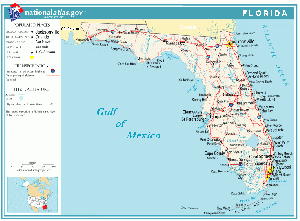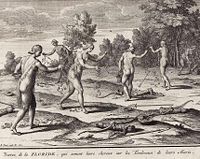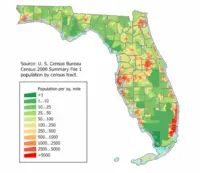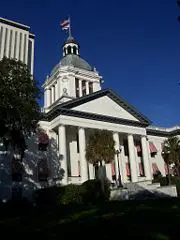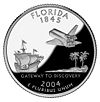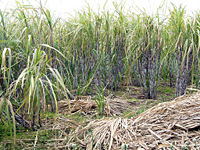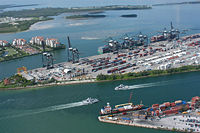Difference between revisions of "Florida" - New World Encyclopedia
Vicki Phelps (talk | contribs) |
Vicki Phelps (talk | contribs) |
||
| Line 305: | Line 305: | ||
*[http://wikis.ala.org/godort/index.php/Florida List of searchable databases produced by Florida state agencies] hosted by the [http://wikis.ala.org/godort/index.php/Main_Page American Library Association Government Documents Roundtable]. Retrieved December 21, 2007. | *[http://wikis.ala.org/godort/index.php/Florida List of searchable databases produced by Florida state agencies] hosted by the [http://wikis.ala.org/godort/index.php/Main_Page American Library Association Government Documents Roundtable]. Retrieved December 21, 2007. | ||
<br clear=all/> | <br clear=all/> | ||
| − | |||
| − | |||
| − | |||
| − | |||
| − | |||
| − | |||
| − | |||
[[Category:Nations and places]] | [[Category:Nations and places]] | ||
{{Credit|179307977}} | {{Credit|179307977}} | ||
Revision as of 21:04, 25 September 2008
Template:US state
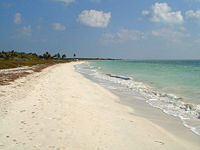
The State of Florida is located in the southeastern region of the United States. Most of the state is a large peninsula with the Gulf of Mexico on its west and the Atlantic Ocean on its east. Florida is the fourth most populated state in the country, behind California, Texas, and New York.[1]
History
Archaeological research indicates that Florida had been inhabited for thousands of years before any European settlements. Of the many indigenous peoples, the largest known were the Ais, the Apalachee, the Calusa, the Timucua and the Tocobago tribes. Juan Ponce de León, a Spanish conquistador, named Florida in honor of his discovery of the land on April 2, 1513, during Pascua Florida, a Spanish term for the Easter season. From that date forward, the land became known as "La Florida." (Juan Ponce de León may not have been the first European to reach Florida; according to one report, at least one indigenous tribesman who he encountered in Florida in 1513 spoke Spanish.[2]
Over the following century, both the Spanish and French established settlements in Florida, with varying degrees of success. In 1559, Spanish Pensacola was established by Don Tristán de Luna y Arellano as the first European settlement in the continental United States, but it had become abandoned by 1561 and would not be reinhabited until the 1690s. French Huguenots founded Fort Caroline in modern-day Jacksonville in 1564, but the fort was conquered by forces from the new Spanish colony of St. Augustine the following year. After Huguenot leader Jean Ribault had learned of the new Spanish threat, he launched an expedition to sack the Spanish settlement; en route, however, severe storms at sea waylaid the expedition, which consisted of most of the colony's men, allowing St. Augustine founder Pedro Menéndez de Avilés time to march his men over land and conquer Fort Caroline. Most of the Huguenots were slaughtered, and Menéndez de Avilés marched south and captured the survivors of the wrecked French fleet, ordering all but a few Catholics executed beside a river subsequently called Matanzas (Spanish for 'killings'). The Spanish never had a firm hold on Florida, and maintained tenuous control over the region by converting the local tribes, briefly with Jesuits and later with Franciscan friars. The local leaders (caciques) demonstrated their loyalty to the Spanish by converting to Roman Catholicism and welcoming the Franciscan priests into their villages.
The area of Spanish Florida diminished with the establishment of English colonies to the north and French colonies to the west. The English weakened Spanish power in the area by supplying their Creek Indian allies with firearms and urging them to raid the Timucuan and Apalachee client-tribes of the Spanish. The English attacked St. Augustine, burning the city and its cathedral to the ground several times, while the citizens hid behind the walls of the Castillo de San Marcos.
The Spanish, meanwhile, encouraged slaves to flee the English-held Carolinas and come to Florida, where they were converted to Roman Catholicism and given freedom. They settled in a buffer community north of St. Augustine, called Gracie Real de Santa Teresa de Mose, the first completely black settlement in what would become the United States.
Great Britain gained control of Florida diplomatically in 1763 through the Peace of Paris (the Castillo de San Marcos surrendered for the first time, having never been taken militarily). Britain divided the colony into East Florida, with its capital at St. Augustine, and West Florida, with its capital at Pensacola. Britain tried to develop the Floridas through the importation of immigrants for labor, including some from Minorca and Greece, but this project ultimately failed. Spain regained the Floridas after Britain's defeat by the American colonies and the subsequent Treaty of Versailles in 1783, continuing the division into East and West Florida. They offered land grants to anyone who settled in the colonies, and many Americans moved to them. This Americanization resulted, by terms of the Adams-Onís Treaty of 1819, in Spain ceding Florida to the United States in exchange for the Americans' renunciation of any claims on Texas and $5 million.
On March 3, 1845, Florida became the 27th state of the United States of America. Its population grew slowly. By 1860 it had only 140,424 people, of whom 44 percent were enslaved. There were fewer than 1,000 free people of color before the Civil War.[3]
On January 10, 1861, before the formal outbreak of the Civil War, Florida seceded from the Union; ten days later, the state became a founding member of the Confederate States of America. The war ended in 1865. On June 25, 1868, Florida's congressional representation was restored.
Until the mid-twentieth century, Florida was the least populous Southern state. The climate, tempered by the growing availability of air conditioning, and low cost of living made the state a haven. Migration from the Rust Belt and the Northeast sharply increased the population. Economic prosperity combined with Florida's sudden elevation in profile led to the Florida land boom of the 1920s, which brought a brief period of intense land development before the Great Depression brought it all to a halt.
Florida's economy would not fully recover until World War II. Today, with an estimated population of over 18 million, Florida is the most populous state in the Southeastern United States, the second most populous state in the South behind Texas, and the fourth most populous in the United States. The Census Bureau estimates that "Florida, now the fourth most populous state, would edge past New York into third place in total population by 2011".[4] [5]
Geography
Florida is situated mostly on a large peninsula between the Gulf of Mexico, the Atlantic Ocean, and the Straits of Florida. It extends to the northwest into a panhandle, extending along the northern Gulf of Mexico. It is bordered on the north by the states of Georgia and Alabama, and on the west, at the end of the panhandle, by Alabama. It is near the countries of the Caribbean, particularly the Bahamas and Cuba.
Florida is one of the largest states east of the Mississippi. Only Alaska and Michigan are larger in water area.
The Florida peninsula is a porous plateau of karst limestone sitting atop bedrock. Extended systems of underwater caves, sinkholes and springs are found throughout the state and supply most of the water used by residents. The limestone is topped with sandy soils deposited as ancient beaches over millions of years as global sea levels rose and fell. During the last Ice Age, lower sea levels and a drier climate revealed a much wider peninsula, largely desert. At the southern end of the peninsula, the Everglades are in fact an enormously wide, very slow-flowing river.

At 345 feet (105 m) above mean sea level, Britton Hill is the highest point in Florida and the lowest high point of any U.S. state.[6]Much of the interior of Florida, typically 25 miles (40 km) or more away from the coastline, features hills with elevations ranging from 100 to 250 feet (30 – 76 m) in many locations.
Climate
The climate of Florida is tempered somewhat by its proximity to water. Most of the state has a humid subtropical climate, except for the southern part below Lake Okeechobee which has a true tropical climate.[7] Cold fronts can occasionally bring high winds and cool to cold temperatures to the entire state during late fall and winter. The seasons in Florida are determined more by precipitation than by temperature with mild to cool, relatively dry winters and autumns (the dry season) and hot, wet springs and summers (the wet season). The Gulf Stream has a moderating effect on the climate, and although much of Florida commonly sees a high summer temperature over 90°F (32°C), the mercury seldom exceeds 100°F (38°C).
The Florida Keys, being surrounded by water, have a more tropical climate, with less variability in temperatures. At Key West, temperatures rarely exceed 90°F in the summer or fall below 60°F in the winter, and frost has never been reported in the Keys.
Florida's nickname is the "Sunshine State," but severe weather is a common occurrence in the state. Central Florida is known as the lightning capital of the United States, as it experiences more lightning strikes than anywhere else in the country. Florida has the highest average precipitation of any state, in large part because afternoon thunderstorms are common in most of the state from late spring until early autumn. These thunderstorms, caused by collisions between airflow from the Gulf of Mexico and airflow from the Atlantic Ocean, pop up in the early afternoon and can bring heavy downpours, high winds, and sometimes tornadoes. Florida leads the United States in tornadoes per square mile, but these tornadoes do not typically reach the intensity of those in the Midwest and Great Plains. Hail often accompanies the most severe thunderstorms.
Snow is a rare occurrence. During the Great Blizzard of 1899, Florida experienced blizzard conditions. The most widespread snowfall in Florida history happened on January 19, 1977, when snow fell over much of the state in different times of the month. Snow flurries fell on Miami Beach for the only time in recorded history.
Although some storms have formed out of season, tropical cyclones pose a severe threat during hurricane season, which lasts from June 1 to November 30. Florida is the most hurricane-prone US state, with subtropical or tropical water on three sides and a lengthy coastline. It is rare for a hurricane season to pass without any impact in the state by at least a tropical storm.
Fauna
Florida is host to many types of wildlife including:
- Marine Mammals : Bottlenose Dolphin, Pilot Whale, Northern Right Whale, Manatee
- Reptiles: Alligator, Crocodile, Eastern Diamondback and Pygmy Rattlesnakes, Gopher Tortoise, Green & Leatherback Sea Turtles, Indigo Snake
- Mammals: Panther, Whitetail Deer, Key Deer, Bobcats, Southern Black Bear, Armadillos
- Birds: Bald Eagle, Crested Caracara, Snail Kite, Osprey, Pelicans, Sea Gulls, Whooping & Sandhill Cranes, Roseate Spoonbill, Florida Scrub Jay (endemic), and many more. Note : Florida is a winter home for most species of eastern North American birds.
Environmental issues
Florida ranks forty-sixth in total energy consumption per capita, despite the heavy reliance on air conditioners and pool pumps. This includes coal, natural gas, petroleum, and retail electricity sales. It is estimated that only 1% of energy in the state is generated through renewable resources.[8]
Increasing landfill space is also an issue. St. Lucie County is planning to experiment with burning trash through plasma arc gasification to generate energy and reduce landfill space. The experiment will be the largest of its kind in the world to date, and begin operation no later than 2009. If successful, experts estimate that the entire St. Lucie County landfill, estimated to contain 4.3 million tons of trash, will disappear within 18 years. Materials created in the energy production can also be used in road construction.[9]
Some are concerned about the effects of climate change and blame it for the major hurricanes of 2004 and 2005; however, recent research suggests the storms are part of a natural cycle and not Global Warming.[10][11]
In July 2007, Florida Governor Charlie Crist announced plans to sign executive orders that would impose strict new air-pollution standards in the state, with aims to reduce so called "greenhouse-gas" emissions by 80 percent of 1990 levels by 2050. Crist's orders would set new emissions targets for power companies, automobiles and trucks, and toughen conservation goals for state agencies and require state-owned vehicles to use alternative fuels.[12]
Red tide has also been an issue on the Southwest coast of Florida. While there has been a great deal of conjecture over the cause of the toxic algae bloom, there is no evidence that it is being caused by pollution or that there has been an increase in the duration or frequency of red tides.[13]
Since their accidental importation from South America into North America in the 1930s, the Red imported fire ant population has increased its territorial range to include most of the Southern United States, including Florida. They are more aggressive than most native ant species and have a painful sting.[14]
Demographics
Population
| Historical populations | |||
|---|---|---|---|
| Census | Pop. | %±
| |
| 1830 | 34,730 | ||
| 1840 | 54,477 | 56.9% | |
| 1850 | 87,445 | 60.5% | |
| 1860 | 140,424 | 60.6% | |
| 1870 | 187,748 | 33.7% | |
| 1880 | 269,493 | 43.5% | |
| 1890 | 391,422 | 45.2% | |
| 1900 | 528,542 | 35.0% | |
| 1910 | 752,619 | 42.4% | |
| 1920 | 968,470 | 28.7% | |
| 1930 | 1,468,211 | 51.6% | |
| 1940 | 1,897,414 | 29.2% | |
| 1950 | 2,771,305 | 46.1% | |
| 1960 | 4,951,560 | 78.7% | |
| 1970 | 6,789,443 | 37.1% | |
| 1980 | 9,746,324 | 43.6% | |
| 1990 | 12,937,926 | 32.7% | |
| 2000 | 15,982,378 | 23.5% | |
| Est. 2006 | 18,089,888 | 13.2% | |
Florida has the 4th highest state population in the United States . The center of population of Florida is located in Polk County, in the town of Lake Wales.[15] As of 2006, Florida's population was 18,089,888; an increase of 2,107,510 (over 13%) from 2000. The state grew 321,647, or 1.8% from 2005. Florida grows an average of 26,803 every month, 6700 every week, and 957 daily. Florida is the nation's third-fastest-growing state.[16]
Ancestry Groups
| Demographics of Florida (csv) | |||||
|---|---|---|---|---|---|
| By race | White | Black | AIAN | Asian | NHPI |
| AIAN is American Indian or Alaskan Native - NHPI is Native Hawaiian or Pacific Islander | |||||
| 2000 (total population) | 82.45% | 15.66% | 0.75% | 2.11% | 0.16% |
| 2000 (Hispanic only) | 15.94% | 0.74% | 0.14% | 0.09% | 0.03% |
| 2005 (total population) | 81.47% | 16.31% | 0.84% | 2.52% | 0.18% |
| 2005 (Hispanic only) | 18.48% | 0.87% | 0.21% | 0.11% | 0.04% |
| Growth 2000-2005 (total population) | 9.99% | 15.93% | 23.95% | 33.09% | 29.08% |
| Growth 2000-2005 (non-Hispanic only) | 5.43% | 15.23% | 15.67% | 32.55% | 24.49% |
| Growth 2000-2005 (Hispanic only) | 28.99% | 29.93% | 58.98% | 45.89% | 45.66% |
The largest reported ancestries in the 2000 Census were German (11.8%), Irish (10.3%), English (9.2%), American (8%), Italian (6.3%), French (2.8%), Polish (2.7%) and Scottish (1.8%).[17]
Before the American Civil War, when slavery was legal, and during the Reconstruction era that followed, African Americans made up nearly half of the state's population.[18] Their proportion declined over the next century, as many moved north in the Great Migration while large numbers of northern whites moved to the state. Recently, the state's proportion of black residents has begun to grow again. Today, large concentrations of black residents can be found in northern Florida (notably in Jacksonville, Gainesville and Pensacola), the Tampa Bay area, the Orlando area (especially in the city of Orlando and Sanford), and South Florida (where their numbers have been bolstered by significant immigration from Haiti and Jamaica).
Florida's Hispanic population includes large communities of Cuban Americans in Miami and Tampa, Puerto Ricans in Tampa and Orlando, and Central American migrant workers in inland West-Central and South Florida. The Hispanic community continues to grow more affluent and mobile: between the years of 2000 and 2004, Lee County in Southwest Florida, which is largely suburban in character, had the fastest Hispanic population growth rate of any county in the United States.
Whites of all ethnicities are present in all areas of the state. Those of British and Irish ancestry are present in large numbers in all the urban/suburban areas across the state. There is a large German population in Southwest Florida, a large Greek population in the Tarpon Springs area, a sizable and historic Italian community in the Miami area, and white Floridians of longer-present generations in the culturally southern areas of inland and northern Florida. Native white Floridians, especially those who have descended from long-time Florida families, affectionately refer to themselves as "Florida crackers." Like all the other southern states, they descend mainly from Scots-Irish as well as some British settlers.
Languages
As of 2000, 76.91 percent of Florida residents age 5 and older spoke only English at home as a first language, while 16.46 percent spoke Spanish, and French-based creole languages (predominantly Haitian Creole) was spoken by 1.38 percent of the population. French was spoken by 0.83 percent, followed by German at 0.59 percent, and Italian at 0.44 percent of all residents.[19].
Florida's climate makes it a popular state for immigrants. Florida's public education system identifies over 200 first languages other than English spoken in the homes of students. In 1990, the League of United Latin American Citizens (LULAC) won a class action lawsuit against the state Department of Education that required educators to be trained in teaching English for speakers of other languages.
Article II, Section 9, of the Florida Constitution provides that "English is the official language of the State of Florida." This provision was adopted in 1988 by a vote following an Initiative Petition.
Religion
Florida is mostly Protestant, with a Roman Catholic community that is growing because of immigration; it is now the single largest denomination in the state. There is also a sizable Jewish community, located mainly in South Florida; no other Southern state has such a large Jewish population. Florida's current religious affiliations are shown in the table below:
- Christian, 81%
- Protestant, 54%
- Baptist, 19%
- Methodist, 6%
- Presbyterian, 4%
- Episcopal, 3%
- Lutheran, 3%
- Pentecostal, 3%
- Other Protestant, 16%
- Roman Catholic, 26%
- Mormon/LDS – 1%
- Protestant, 54%
- Jewish, 4%
- other religions, 1%
- non-religious, 14%
Government
| Year | Republican | Democratic |
|---|---|---|
| 2004 | 52.10% 3,964,522 | 47.09% 3,583,544 |
| 2000 | 48.85% 2,912,790 | 48.84% 2,912,253 |
| 1996 | 42.32% 2,244,536 | 48.02% 2,546,870 |
| 1992 | 40.89% 2,173,310 | 39.00% 2,072,698 |
| 1988 | 60.87% 2,618,885 | 38.51% 1,656,701 |
| 1984 | 65.32% 2,730,350 | 34.66% 1,448,816 |
| 1980 | 55.52% 2,046,951 | 38.50% 1,419,475 |
| 1976 | 46.64% 1,469,531 | 51.93% 1,636,000 |
| 1972 | 71.91% 1,857,759 | 27.80% 718,117 |
| 1968 | 40.53% 886,804 | 30.93% 676,794 |
| 1964 | 48.85% 905,941 | 51.15% 948,540 |
| 1960 | 51.51% 795,476 | 48.49% 748,700 |
The state government consists of three separate branches: judicial, executive, and legislative. The legislature enacts bills, which, if signed by the governor, become Florida Statutes.
The Florida Legislature comprises the Florida Senate, which has 40 members, and the Florida House of Representatives, which has 120 members. The current Governor of Florida is Republican Charlie Crist.
There are 67 counties in Florida, but some reports show only 66 because of Duval County, which is consolidated with the City of Jacksonville.
Florida was traditionally a Democratic state; at one time, 68.5 percent of all Floridians were registered Democrats. In the last decades of the twentieth century, the realignment of the "Solid South" has led many conservative Democrats of Florida to vote with the Republican Party. This tendency, combined with explosive population growth, which has brought many Republicans into the state as well as Cuban immigration has given Florida a Republican edge in practice. As a result, Republicans control the governorship and most other statewide elective offices: both houses of the state legislature, 16 of the state's 25 seats in the House of Representatives, and one of the state's two Senate seats. Because of the state's population and number of electoral votes, political analysts consider it to be a key swing state in presidential elections, which became obvious during the 2000 election where Florida played a key role in the election.
Economy
The gross state product of Florida in 2005 was $596 billion. Its GDP is one of the fastest-growing in the nation, with a 7.7% increase from 2004 to 2005.[20] Personal income was $30,098 per capita, ranking 26th in the nation.
Tourism makes up the largest sector of the state economy. Warm weather and hundreds of miles of beaches attract about 60 million visitors to the state every year. Amusement parks, especially in the Orlando area, make up a significant portion of tourism. The Walt Disney World Resort is the largest vacation resort in the world, consisting of four theme parks and more than 20 hotels in Lake Buena Vista, Florida; it, and Universal Orlando Resort, Busch Gardens, SeaWorld, and other major parks drive state tourism. Many beach towns are also popular tourist destinations, particularly in the winter months.
The second largest industry is agriculture. Citrus fruit, especially oranges, are a major part of the economy, and Florida produces the majority of citrus fruit grown in the U.S. – in 2006 67 percent of all citrus, 74 percent of oranges, 58 percent of tangerines, and 54 percent of grapefruit. About 95 percent of commercial orange production in the state is destined for processing (mostly as orange juice, the official state beverage).[21] Citrus canker continues to be an issue of concern. Other products include sugarcane and celery.[22] The Everglades Agricultural Area is a major center for agriculture. The environmental impact of agriculture — especially water pollution— is a major issue in Florida today.
Phosphate mining, concentrated in the Bone Valley, is the state's third-largest industry. The state produces about 75 percent of the phosphate required by farmers in the United States and 25 percent of the world supply, with about 95 percent used for agriculture (90 percent for fertilizer and 5 percent for livestock feed supplements) and 5 percent used for other products.[23]
Since the arrival of the NASA Merritt Island launch sites on Cape Canaveral (most notably Kennedy Space Center) in 1962, Florida has developed a sizable aerospace industry.
In addition, the state has seen a recent boom in medical and bio-tech industries throughout its major metropolitan areas. Orlando was recently chosen as the official site for the new headquarters of the Burnham Institute, a major bio-tech and medical research company.
The state was one of the few states to not have a state minimum wage law until 2004, when voters passed a constitutional amendment establishing a state minimum wage and (unique among minimum wage laws) mandating that it be adjusted for inflation every six months. Currently, the minimum wage in the state of Florida is $6.67.
Historically, Florida's economy was based upon cattle farming and agriculture (especially sugarcane, citrus, tomatoes, and strawberries). In the early 1900, land speculators discovered Florida, and businessmen such as Henry Plant and Henry Flagler developed railroad systems, which led people to move in, drawn by the weather and local economies. From then on, tourism boomed, fueling a cycle of development that overwhelmed a great deal of farmland.
In 2004 and 2005, key industries along the west coast—commercial fishing and water-based tourist activities (sports fishing and diving)—were threatened by outbreaks of red tide, a discoloration of seawater caused by an efflorescence of toxin-producing dinoflagellates.
Florida is one of the nine states that do not impose a personal income tax. The state had imposed a tax on "intangible personal property" (stocks, bonds, mutual funds, money market funds, etc.), but this tax was abolished after 2006. The state sales tax rate is 6 percent[24].
Notes
- ↑ United States population by states, United States Census Bureau. Retrieved December 21, 2007.
- ↑ Smith, Hale G., and Marc Gottlob. 1978. "Spanish-Indian Relationships: Synoptic History and Archaeological Evidence, 1500-1763." In Tacachale: Essays on the Indians of Florida and Southeastern Georgia during the Historic Period. Edited by Jerald Milanich and Samuel Proctor. Gainesville, Florida: University Presses of Florida. ISBN 0-8130-0535-3. Retrieved December 21, 2007.
- ↑ Historical Census Browser. Retrieved December 21, 2007.
- ↑ U.S. Census Bureau News; “Florida, California and Texas to Dominate Future Population Growth, Census Bureau Reports”; April 21, 2005. Retrieved December 21, 2007.
- ↑ http://www.census.gov/Press-Release/www/releases/archives/population/004704.html. Retrieved December 21, 2007.
- ↑ Florida, the Sunshine State. Welcome to America. Retrieved December 21, 2007.
- ↑ Ritter, Michael. Wet/Dry Tropical Climate. University of Wisconsin, Stevens Point. Retrieved December 21, 2007.
- ↑ Swartz, Kristi E. Emission Concern Unites Industry, Advocates. Harvard University: John F. Kennedy School of Government. Retrieved December 21, 2007.
- ↑ "Florida county plans to vaporize landfill trash", Associated Press, 9 September 2006. Retrieved December 21, 2007.
- ↑ Than, Ker, "Many More Hurricanes To Come", Live Science, 31 August 2005. Retrieved December 21, 2007.
- ↑ NOAA Attributes Recent Increase In Hurricane Activity To Naturally Occurring Multi-Decadal Climate Variability. National Oceanic and Atmospheric Administration. Retrieved December 21, 2007.
- ↑ Loney, Jim, "Florida To Introduce Tough Greenhouse Gas Targets", Reuters, 12 July 2007. Retrieved December 21, 2007.
- ↑ Daley, Beth, "Tide's toxins trouble lungs ashore", 'Boston Globe', 28 March 2005. Retrieved December 21, 2007.
- ↑ Not all alien invaders are from outer space. United States Department of Agriculture. Retrieved December 21, 2007.
- ↑ Population and Population Centers by State: 2000. US Census Bureau. Retrieved December 21, 2007.
- ↑ Projected Population Growth Through 2015 - April 2005. Business Council of New York State. Retrieved December 21, 2007.
- ↑ Florida Factstreet. US Census Bureau. Retrieved December 21, 2007.
- ↑ Compendium of the Ninth Census:Population, with race. (.PDF). US Census Bureau. Retrieved 2007-12-03. Retrieved December 21, 2007.
- ↑ Most spoken languages in Florida. Modern Language Association. Retrieved December 21, 2007.
- ↑ Advance Estimates of GDP by State for 2005 by NAICS Sector. Bureau of Economic Analysis. Retrieved December 21, 2007.
- ↑ Commodity Profile: Citrus. Agricultural Issues Center, University of California. Retrieved December 21, 2007.
- ↑ Crop Profile for Celery in Florida. NSF Center for Integrated Pest Management, North Carolina State University. Retrieved December 21, 2007.
- ↑ About Phosphate. The Mosaic Company. Retrieved December 21, 2007.
- ↑ Florida Sales and Use Tax. State of Florida. Retrieved December 21, 2007.
ReferencesISBN links support NWE through referral fees
External links
- Florida Memory Project Over 300,000 photographs and documents from the State Library & Archives of Florida. Retrieved December 21, 2007.
- Online collection of the Spanish Land Grants. Retrieved December 21, 2007.
- USGS real-time, geographic, and other scientific resources of Florida. Retrieved December 21, 2007.
- University of Florida Digital Collections Digital collections of texts and images, including Florida aerial photography, ephemeral photographs and postcards, letters, and more. Retrieved December 21, 2007.
- U.S. Census Bureau. Retrieved December 21, 2007.
- Economic and farm demographics fact sheet from the USDA. Retrieved December 21, 2007.
- List of searchable databases produced by Florida state agencies hosted by the American Library Association Government Documents Roundtable. Retrieved December 21, 2007.
Credits
New World Encyclopedia writers and editors rewrote and completed the Wikipedia article in accordance with New World Encyclopedia standards. This article abides by terms of the Creative Commons CC-by-sa 3.0 License (CC-by-sa), which may be used and disseminated with proper attribution. Credit is due under the terms of this license that can reference both the New World Encyclopedia contributors and the selfless volunteer contributors of the Wikimedia Foundation. To cite this article click here for a list of acceptable citing formats.The history of earlier contributions by wikipedians is accessible to researchers here:
The history of this article since it was imported to New World Encyclopedia:
Note: Some restrictions may apply to use of individual images which are separately licensed.
